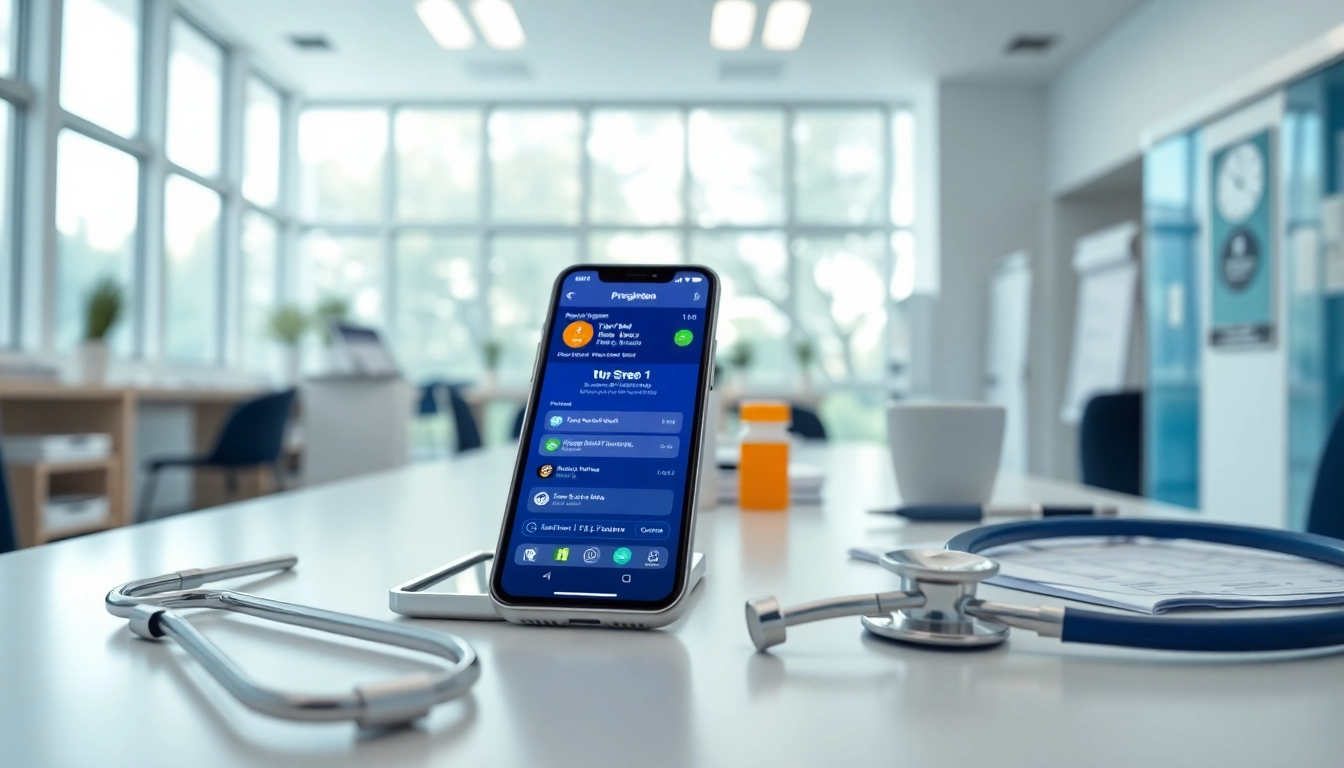Understanding E-Prescribing Software
What is E-Prescribing Software?
E-prescribing software, or electronic prescribing software, is a digital tool designed to facilitate the electronic transmission of prescriptions from healthcare providers to pharmacies. This system streamlines the medication ordering process, replacing traditional paper prescriptions with electronic orders that can be sent instantly and securely. E-prescribing not only enhances the accuracy of prescriptions but also mitigates potential errors associated with handwritten notes, such as misinterpretations or illegible handwriting.
Benefits of E-Prescribing Software
Adopting e-prescribing software offers a multitude of benefits for healthcare providers, pharmacies, and patients alike. Some of the key advantages include:
- Increased Efficiency: E-prescribing dramatically reduces the time spent on processing prescriptions. Healthcare providers can send prescriptions directly to pharmacies, eliminating the need for faxing or calling in orders.
- Enhanced Accuracy: The software helps to decrease errors related to handwriting and miscommunication. Prescriptions are generated based on standardized dosing guidelines and patient records, which can also include drug interactions and allergies.
- Improved Patient Safety: By integrating e-prescribing into their systems, clinicians have the tools to avoid contraindications, duplicate therapies, and other safety hazards that could arise from traditional prescribing methods.
- Convenience for Patients: Patients benefit from the convenience of having their prescriptions filled more quickly and accurately. They can also receive reminders for refills and track their medications more efficiently.
- Regulatory Compliance: E-prescribing software increasingly incorporates features that meet regulatory standards, facilitating compliance with federal and state laws pertaining to electronic prescriptions.
Key Features to Look For
When evaluating e-prescribing software, it is essential to consider a variety of features that can enhance functionality and deliver value to your practice. Key features to pay attention to include:
- User-Friendly Interface: The software should have an intuitive design that allows for easy navigation and quick adoption by staff.
- Integration Capabilities: Ensure that the e-prescribing software can integrate seamlessly with existing electronic health records (EHR) systems and other clinical software used within the practice.
- Robust Prescription Tracking: Look for software that enables tracking of prescriptions, including when they are sent, filled, and refilled, as well as any associated patient notes.
- Drug Interaction Alerts: Advanced software should include features that alert providers of potential drug interactions based on patient medications and allergies before finalizing a prescription.
- Patient Portal Options: Allowing patients to access their medication information through a secure portal can improve engagement and adherence to treatment plans.
Evaluating E-Prescribing Software Reviews
How to Assess User Reviews
When exploring eprescribing software reviews, it is crucial to evaluate the feedback from actual users thoughtfully. Here are several methods you can employ to ensure a comprehensive assessment:
- Look for Specific Details: Reviews that include specific details about the functionality, customer support, and user experience tend to be more reliable than generic praise or criticism.
- Identify Patterns: If multiple reviews mention the same issue or highlight the same feature positively, that may indicate a legitimate trend worth considering.
- Consider the Source: Check whether the review platforms provide verified user feedback or if they allow anonymous submissions, which can sometimes lead to misinformation.
- Check for Updates: Software updates can radically change functionality. Look for recent reviews that discuss updates, user experience, and any enhancements made through newer versions.
Common Pitfalls in Software Evaluation
While reviewing e-prescribing software, it’s important to be aware of common pitfalls that can skew assessments:
- Overreliance on Star Ratings: Star ratings may not provide a complete picture; qualitative reviews often hold more value.
- Ignoring the Context: Some reviews might come from users in different practice settings. Consider how the software performs in environments similar to your own.
- Fall for Biased Reviews: Be cautious of reviews that lack substance and seem overly promotional or heavily critical without justification. Look for balanced assessments.
Importance of Genuine Feedback
Genuine feedback is essential when selecting e-prescribing software. Real-world experiences can offer insights into the app’s reliability and usability that specifications alone cannot provide. Pay particular attention to:
- User Satisfaction: Look for mentions of positive experiences and satisfaction levels.
- Support and Customer Service: Review how responsive the vendor is to user issues, as this can affect your practice’s operational efficiency.
- Feedback on Upgrades and Updates: Genuine user reviews often mention how the software vendor handles updates and their impact on overall functionality.
Comparative Analysis of Top E-Prescribing Software
Key Metrics for Comparison
To effectively compare different e-prescribing solutions, establish key performance metrics that align with your practice needs. Important metrics include:
- Cost of the Software: Evaluate the complete pricing structure, including monthly fees, transaction fees, and any hidden costs.
- User Adoption Rates: How quickly are users able to adapt to the software? High adoption rates often point to intuitive design.
- Feature Set: Compare essential features across different platforms to determine which offers the most comprehensive solutions for your practice.
- Customer Support: Assess the quality and availability of customer support across different platforms.
Squaring Up Features and Pricing
When selecting e-prescribing software, it is essential to analyze the relationship between features and pricing. A higher price does not always equate to better performance; assess the total cost of ownership against the value delivered.
- Feature Necessity: Prioritize features that are critical to your practice. Avoid paying extra for features that are not needed.
- Negotiating Costs: Many vendors are willing to negotiate pricing, especially when it comes to longer-term contracts or bundling services.
- Trial Options: Take advantage of free trials or demos when available to better understand if the pricing aligns with your expectations of what the software should deliver.
User Experience: A Comparative Outlook
User experience plays a vital role in the success of e-prescribing software. Evaluate how software performs in real-world settings by looking at:
- Interface Usability: Is the interface navigable? Are common tasks readily accessible?
- Responsiveness and Speed: Assess how quickly the program generates prescriptions and processes requests.
- Mobile Accessibility: Determine if the software has a mobile application or responsive design suitable for users on the go.
Implementing E-Prescribing Software in Practice
Steps for Successful Integration
Integrating e-prescribing software into your practice requires careful planning and execution. Follow these steps to ensure a successful rollout:
- Establish Clear Objectives: Identify goals you want to achieve with e-prescribing, like reducing prescription errors or improving wait times.
- Plan the Implementation Schedule: Develop a timeline that considers training periods, system testing, and the final launch.
- Engage Stakeholders: Include input from all relevant staff members, from physicians to pharmacists, to ensure the system meets diverse needs.
- Monitor Progress: After implementation, continuously monitor performance to detect any issues early and make necessary adjustments.
Training Staff on New Systems
Staff training is crucial to the successful adoption of e-prescribing software. Consider the following approaches:
- Comprehensive Training Programs: Design programs that cover everything from basic operations to troubleshooting common issues.
- Regular Refresher Courses: As software updates occur, staff should receive updated training to keep abreast of new features and functionalities.
- Feedback Mechanism: Create channels for staff to provide feedback about their experiences with the new system, which can aid in continuous improvement.
Measuring the Impact of E-Prescribing Software
After implementation, it is essential to evaluate the effectiveness of e-prescribing software. Pay attention to:
- Prescription Error Rates: Track changes in error rates pre- and post-implementation to gauge improvements in accuracy.
- Workflow Efficiency: Assess how much time is saved through quicker processing of prescriptions and reduced paperwork.
- Patient Satisfaction: Gather patient feedback on their experiences with the e-prescribing process, which can provide valuable insights for future improvements.
Future Trends in E-Prescribing
Emerging Technologies in E-Prescribing
The landscape of e-prescribing is continually evolving with technological advancements. Some emerging trends to watch include:
- Artificial Intelligence: AI is beginning to play a role in prescription management, offering predictive analytics that can improve decision-making based on patient history.
- Blockchain Technology: Enhancing security and transparency in prescription transactions, blockchain could revolutionize how prescriptions are managed and tracked.
The Role of Regulatory Changes
Staying informed about changing regulations is vital for any practice utilizing e-prescribing software. Future changes in legislation may dictate new features or compliance standards that software vendors must meet. Understanding these changes can help practices to adjust proactively rather than reactively.
Patient-Centric Innovations on the Horizon
As the healthcare landscape continues to shift towards a more patient-centered focus, expect e-prescribing software to integrate features that enhance patient engagement. Innovations might include:
- Personalized Communication: Notifying patients about their prescriptions via text or app notifications to increase their involvement in their healthcare journey.
- Smart Reminders: Automating alerts for medication refills based on patient adherence patterns to optimize treatment outcomes.











Leave a Reply